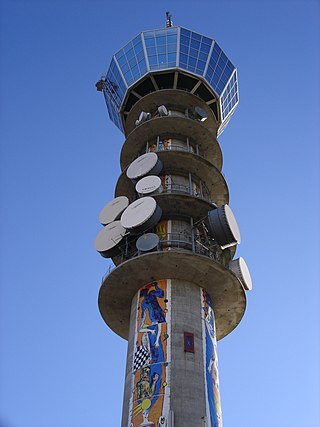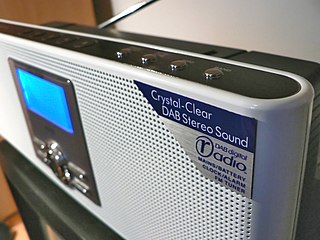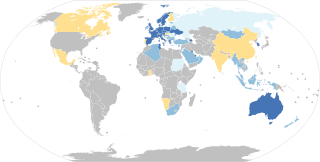
In electronics and telecommunications, a radio transmitter or just transmitter is an electronic device which produces radio waves with an antenna with the purpose of signal transmission up to a radio receiver. The transmitter itself generates a radio frequency alternating current, which is applied to the antenna. When excited by this alternating current, the antenna radiates radio waves.

In telecommunications, a carrier wave, carrier signal, or just carrier, is a waveform that is modulated (modified) with an information-bearing signal for the purpose of conveying information.
MPEG-1 Audio Layer II or MPEG-2 Audio Layer II is a lossy audio compression format defined by ISO/IEC 11172-3 alongside MPEG-1 Audio Layer I and MPEG-1 Audio Layer III (MP3). While MP3 is much more popular for PC and Internet applications, MP2 remains a dominant standard for audio broadcasting.

Radio broadcasting is the broadcasting of audio (sound), sometimes with related metadata, by radio waves to radio receivers belonging to a public audience. In terrestrial radio broadcasting the radio waves are broadcast by a land-based radio station, while in satellite radio the radio waves are broadcast by a satellite in Earth orbit. To receive the content the listener must have a broadcast radio receiver (radio). Stations are often affiliated with a radio network that provides content in a common radio format, either in broadcast syndication or simulcast, or both. Radio stations broadcast with several different types of modulation: AM radio stations transmit in AM, FM radio stations transmit in FM, which are older analog audio standards, while newer digital radio stations transmit in several digital audio standards: DAB, HD radio, DRM.
DVB-T, short for Digital Video Broadcasting – Terrestrial, is the DVB European-based consortium standard for the broadcast transmission of digital terrestrial television that was first published in 1997 and first broadcast in Singapore in February, 1998. This system transmits compressed digital audio, digital video and other data in an MPEG transport stream, using coded orthogonal frequency-division multiplexing modulation. It is also the format widely used worldwide for Electronic News Gathering for transmission of video and audio from a mobile newsgathering vehicle to a central receive point. It is also used in the US by Amateur television operators.
In-band on-channel (IBOC) is a hybrid method of transmitting digital radio and analog radio broadcast signals simultaneously on the same frequency. The name refers to the new digital signals being broadcast in the same AM or FM band (in-band), and associated with an existing radio channel (on-channel). By utilizing additional digital subcarriers or sidebands, digital information is multiplexed on existing signals, thus avoiding re-allocation of the broadcast bands.

Digital Radio Mondiale is a set of digital audio broadcasting technologies designed to work over the bands currently used for analogue radio broadcasting including AM broadcasting—particularly shortwave—and FM broadcasting. DRM is more spectrally efficient than AM and FM, allowing more stations, at higher quality, into a given amount of bandwidth, using xHE-AAC audio coding format. Various other MPEG-4 codecs and Opus are also compatible, but the standard now specifies xHE-AAC.
Digital radio is the use of digital technology to transmit or receive across the radio spectrum. Digital transmission by radio waves includes digital broadcasting, and especially digital audio radio services.
Near Instantaneous Companded Audio Multiplex (NICAM) is an early form of lossy compression for digital audio. It was originally developed in the early 1970s for point-to-point links within broadcasting networks. In the 1980s, broadcasters began to use NICAM compression for transmissions of stereo TV sound to the public.

HD Radio (HDR) is a trademark for an in-band on-channel (IBOC) digital radio broadcast technology. HD radio generally simulcasts an existing analog radio station in digital format with less noise and with additional text information. HD Radio is used primarily by AM and FM radio stations in the United States, U.S. Virgin Islands, Canada, Mexico and the Philippines, with a few implementations outside North America.

A single-frequency network or SFN is a broadcast network where several transmitters simultaneously send the same signal over the same frequency channel.

The Mendip transmitting station is a broadcasting and telecommunications facility on the summit of Pen Hill, part of the Mendip Hills range in Somerset, England, at 305 metres (1,001 ft) above sea level. The station is in St Cuthbert Out civil parish, approximately 2 miles (3.2 km) north-east of Wells. Its mast, 293 m (961 ft) high, was built in 1967 and is the tallest structure in South West England. The mast broadcasts digital television, FM analogue radio and DAB digital radio, and had broadcast analogue colour television from 1967 until 2010.

FM broadcasting is a method of radio broadcasting that uses frequency modulation (FM) of the radio broadcast carrier wave. Invented in 1933 by American engineer Edwin Armstrong, wide-band FM is used worldwide to transmit high-fidelity sound over broadcast radio. FM broadcasting offers higher fidelity—more accurate reproduction of the original program sound—than other broadcasting techniques, such as AM broadcasting. It is also less susceptible to common forms of interference, having less static and popping sounds than are often heard on AM. Therefore, FM is used for most broadcasts of music and general audio. FM radio stations use the very high frequency range of radio frequencies.

Digital Radio in the Republic of Ireland is broadcast on a number of digital terrestrial, cable and internet platforms. Until the 31 March 2021, official broadcasts of the digital audio broadcasting standard were also available in the state by Raidió Teilifís Éireann (RTÉ) of their full banquet of radio services. DAB broadcasts since April 2021 are now restricted to unlicensed, low powered multiplexes in a small number of locations.
FMeXtra is a deprecated in-band on-channel digital radio broadcasting technology created by Digital Radio Express. It was intended to allow a second all-digital signal to be simulcast with an existing analog FM radio station, offering a less noisy signal that would be particularly useful in urban environments where multipath distortion can seriously degrade analog FM transmissions. It can also support a second all-digital channel at the same frequency, allowing two channels to be broadcast by a single FM station.

In the United Kingdom, the roll-out of digital radio has been proceeding since engineering test transmissions were started by the BBC in 1990 followed by a public launch in September 1995. The UK currently has one of the world's biggest digital radio networks, with about 500 transmitters, three national DAB ensembles, one regional DAB ensemble, 48 local DAB ensembles and an increasing number of small-scale DAB ensembles broadcasting over 250 commercial and 34 BBC radio stations across the UK. In London there are already more than 100 different digital stations available. In addition to DAB and DAB+, radio stations are also broadcast on digital television platform as well as internet radio in the UK. Digital radio ensemble operators and stations need a broadcasting licence from the UK's media regulator Ofcom to broadcast.

The radio technology known as Digital Audio Broadcasting, and its TV sibling, Digital Multimedia Broadcasting (DMB), is being operated in several regions worldwide, either in the form of full services, or as feasibility studies.

Radio is the technology of communicating using radio waves. Radio waves are electromagnetic waves of frequency between 3 hertz (Hz) and 300 gigahertz (GHz). They are generated by an electronic device called a transmitter connected to an antenna which radiates the waves. They are received by another antenna connected to a radio receiver. In addition to communication, radio is used for radar, radio navigation, remote control, remote sensing, and other applications.
In North American digital terrestrial television broadcasting, a distributed transmission system is a form of single-frequency network in which a single broadcast signal is fed via microwave, landline, or communications satellite to multiple synchronised terrestrial radio transmitter sites. The signal is then simultaneously broadcast on the same frequency in different overlapping portions of the same coverage area, effectively combining many small transmitters to generate a broadcast area rivalling that of one large transmitter or to fill gaps in coverage due to terrain or localised obstacles.

Digital multimedia broadcasting (DMB) is a digital radio transmission technology developed in South Korea as part of the national IT project for sending multimedia such as TV, radio and datacasting to mobile devices such as mobile phones, laptops and GPS navigation systems. This technology, sometimes known as mobile TV, should not be confused with Digital Audio Broadcasting (DAB) which was developed as a research project for the European Union.



















